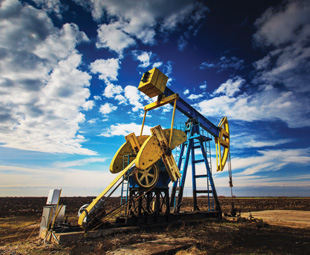To shale or not to shale?

South Africa has one of the largest petrochemical industries in Africa, which is largely centred on coal feedstock, but during the course of the last few years, “shale gas” and “fracking” have become the new buzzwords. CLAIRE RENCKEN investigates.
Let’s start with the basics. First, what is shale gas and why is it important? Shale gas refers to natural gas that is trapped within shale formations. Shales are fine-grained sedimentary rocks that can be rich sources of petroleum and natural gas.
Second, what is fracking? This is the process of drilling down into the earth, before a high-pressure water mixture is directed at the rock to release the gas inside. Water, sand and chemicals are injected into the rock at high pressure, which allows the gas to flow out to the head of the well.
The process is carried out vertically or, more commonly, by drilling horizontally to the rock layer. The process can create new pathways to release gas or can be used to extend existing channels.
Last, one might ask why fracking is controversial. The extensive use of fracking in the United States (US), where it has revolutionised the energy industry, has prompted environmental concerns.
The first of these is that fracking uses huge amounts of water that must be transported to the fracking site, at significant environmental cost. The second is the worry that the potentially carcinogenic chemicals used, may escape and contaminate groundwater around the fracking site. (However, the industry suggests pollution incidents are the result of bad practice, rather than an inherently risky technique.)
There are also worries that the fracking process can cause small earth tremors. Finally, some environmental campaigners say that fracking is simply distracting energy firms and governments from investing in renewable sources of energy, and encouraging continued reliance on fossil fuels.
Many people, however, are of the opinion that the case for, rather than against, natural gas is clear. Displacing coal-fired power with natural gas is the fastest and cheapest route to reducing CO2 emissions in the global power sector over the next 20-plus years.
Last year, coal was responsible for as much as 44 percent of energy-related CO2 emissions – more than any other fuel. And in the run-up to 2020, the incremental increase in emissions from coal-fired power, in India and China alone, is expected to be roughly double the increase from the entire global transport sector.
Natural gas is the fastest way to address these emissions, because modern gas plants emit half the CO2 emissions of new coal plants, and up to 70 percent less CO2 than the old steam-turbine coal plants.
The potential of natural gas as a cleaner transport fuel is also coming into sharper focus. Over the long term, gas can provide a cleaner source of electricity than coal for the world’s growing fleet of electric vehicles. That would ease many countries’ need for imported oil, especially in Asia.
There are also direct applications for gas in transport. One is Liquefied Natural Gas (LNG), which can be used to fuel-heavy vehicles, such as trucks, ships, barges and trains. It’s a smart way to reduce local emissions of sulphur oxides and particulates. It can also help to tackle overall greenhouse emissions, depending on where and how it is used.
So, what does all this mean for South Africa? According to Transport Minister and former Energy Minister Dipuo Peters, the US Energy Information Administration (EIA) findings of 2011, which estimated that South Africa possesses technically recoverable resources of about 485-trillion cubic feet of natural gas in the Karoo basin region, is not something that government can easily ignore.
Speaking at the Wits Business School’s Infrastructure to Support New Oil and Gas Resources in Sub-Saharan Africa seminar in November last year, Peters said that, as part of her stint as Energy Minister, in the first half of 2013, the Department of Energy extensively engaged on the issue of new gas resources that were discovered in South Africa.
Furthermore, she reiterated that government had, in September 2012, lifted the moratorium on shale gas exploration, or hydraulic fracking, and stated that it would actively seek means to advance exploration activities in the Karoo basin in 2014.
“It would be wrong for government not to explore all potential gas opportunities that exist in South Africa, whether it be offshore gas fields or land-based shale gas extractions,” asserts Peters, who adds that shale gas would likely produce 20 times the amount of gas currently produced by national oil company PetroSA.
However, other parties are voicing concerns that natural gas might not be the solution to South Africa’s electricity shortfall and that the so-called “energy boom”, which fracking could potentially bring to South Africa’s economy, would most likely be short-lived.
Arthur Chien, CEO of Talesun Energy, Chinese manufacturer of solar modules and solar cells, says: “Should fracking become the norm in South Africa, the long-term repercussions on the economy, as well as the effect on the environment and public health, may be staggering, not to mention the potential clean-up costs that will fall on taxpayers for decades to come.
“Energy efficiency and renewable energy should be among the country’s top priorities, as they are the cleanest, and are a less expensive solution to South Africa’s electricity supply shortage,” he concludes.
One thing is for sure: supplying the world’s rising energy needs in the years to come is going to be extremely tough. Surely, the most sustainable energy system will be one in which cleaner fossil fuels, as well as renewable sources, meet a growing share of demand.
We cannot ignore the fact that natural gas offers the fastest and cheapest route to reducing CO2 emissions in the global power sector by addressing the threat of coal-fired power. Therefore, the larger the world’s natural gas supplies, the more quickly and economically we can displace coal-fired power.
The world will need to invest heavily in all energy sources – from oil, gas and nuclear to wind, hydro, biofuels and solar.
Published by
Focus on Transport
focusmagsa




